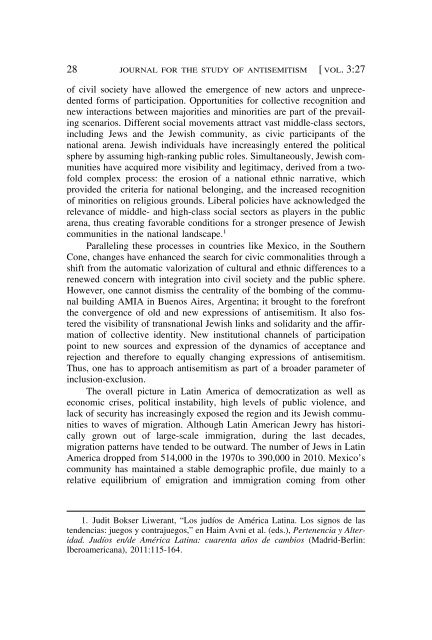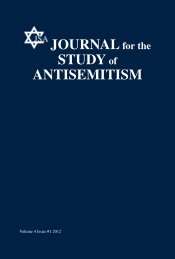JOURNALfor the STUDYof ANTISEMITISM
JOURNALfor the STUDYof ANTISEMITISM
JOURNALfor the STUDYof ANTISEMITISM
Create successful ePaper yourself
Turn your PDF publications into a flip-book with our unique Google optimized e-Paper software.
28 JOURNAL FOR THE STUDY OF <strong>ANTISEMITISM</strong> [ VOL. 3:27<br />
of civil society have allowed <strong>the</strong> emergence of new actors and unprecedented<br />
forms of participation. Opportunities for collective recognition and<br />
new interactions between majorities and minorities are part of <strong>the</strong> prevailing<br />
scenarios. Different social movements attract vast middle-class sectors,<br />
including Jews and <strong>the</strong> Jewish community, as civic participants of <strong>the</strong><br />
national arena. Jewish individuals have increasingly entered <strong>the</strong> political<br />
sphere by assuming high-ranking public roles. Simultaneously, Jewish communities<br />
have acquired more visibility and legitimacy, derived from a twofold<br />
complex process: <strong>the</strong> erosion of a national ethnic narrative, which<br />
provided <strong>the</strong> criteria for national belonging, and <strong>the</strong> increased recognition<br />
of minorities on religious grounds. Liberal policies have acknowledged <strong>the</strong><br />
relevance of middle- and high-class social sectors as players in <strong>the</strong> public<br />
arena, thus creating favorable conditions for a stronger presence of Jewish<br />
communities in <strong>the</strong> national landscape. 1<br />
Paralleling <strong>the</strong>se processes in countries like Mexico, in <strong>the</strong> Sou<strong>the</strong>rn<br />
Cone, changes have enhanced <strong>the</strong> search for civic commonalities through a<br />
shift from <strong>the</strong> automatic valorization of cultural and ethnic differences to a<br />
renewed concern with integration into civil society and <strong>the</strong> public sphere.<br />
However, one cannot dismiss <strong>the</strong> centrality of <strong>the</strong> bombing of <strong>the</strong> communal<br />
building AMIA in Buenos Aires, Argentina; it brought to <strong>the</strong> forefront<br />
<strong>the</strong> convergence of old and new expressions of antisemitism. It also fostered<br />
<strong>the</strong> visibility of transnational Jewish links and solidarity and <strong>the</strong> affirmation<br />
of collective identity. New institutional channels of participation<br />
point to new sources and expression of <strong>the</strong> dynamics of acceptance and<br />
rejection and <strong>the</strong>refore to equally changing expressions of antisemitism.<br />
Thus, one has to approach antisemitism as part of a broader parameter of<br />
inclusion-exclusion.<br />
The overall picture in Latin America of democratization as well as<br />
economic crises, political instability, high levels of public violence, and<br />
lack of security has increasingly exposed <strong>the</strong> region and its Jewish communities<br />
to waves of migration. Although Latin American Jewry has historically<br />
grown out of large-scale immigration, during <strong>the</strong> last decades,<br />
migration patterns have tended to be outward. The number of Jews in Latin<br />
America dropped from 514,000 in <strong>the</strong> 1970s to 390,000 in 2010. Mexico’s<br />
community has maintained a stable demographic profile, due mainly to a<br />
relative equilibrium of emigration and immigration coming from o<strong>the</strong>r<br />
1. Judit Bokser Liwerant, “Los judíos de América Latina. Los signos de las<br />
tendencias: juegos y contrajuegos,” en Haim Avni et al. (eds.), Pertenencia y Alteridad.<br />
Judíos en/de América Latina: cuarenta años de cambios (Madrid-Berlin:<br />
Iberoamericana), 2011:115-164.














